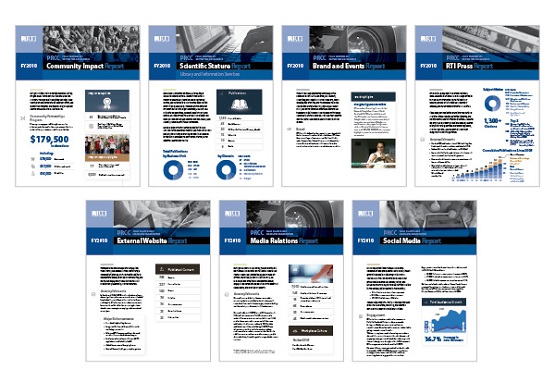
As a corporate communication leader, I am responsible for setting annual objectives for my team and reporting on our progress in achieving our goals. Over the course of a year, I have many opportunities to share our results and impact in meetings, by giving presentations and submitting formal reports to executive leadership. My team does not have the same opportunities, so several years ago I created a means for them to showcase their accomplishments. Beyond providing updates for inclusion in our standard reporting, they are given the opportunity to highlight how they have bolstered the institute’s brand through our communications programs, initiatives, and campaigns. We accomplish this by having each of our primary communications functions produce an annual report summarizing the major accomplishments, highlights, and metrics within their area. Today, we issue seven of these reports, ranging from two to four pages each. Each report is designed and issued as a PDF and printed in small quantities. All are branded as Corporate Communications reports and shared with the RTI International executive leadership team and our board of governors. We are the only department at the institute that produces reports of this type—fully designed and delivered as a suite, recapping the ways in which we have bolstered the institute’s brand through paid, shared, earned, owned, and converged media—as well as supplemental outreach. Each report offers insight into how the department performed with corresponding metrics: While each report is unique in its focus, they all share a common purpose: to raise awareness of how these programs support our broad corporate communications outreach. They can stand alone, but when combined they tell a comprehensive annual story of corporate communications impact. The reports are only shared internally. While I am not usually a fan of what I like to call, “us talking to us,” I have seen the positive impact these reports have had on our communications team. Each department manager takes ownership of the reports they are responsible for producing. Knowing they must produce these annual summaries, the managers keep measurement at the forefront, and it is an ongoing focus in the update and planning discussions they have with me and as a team. The reports have increased accountability for performance but, more importantly, are a source of team pride. Given that the institute’s senior-most leaders see the reports, the managers and their teams really work hard to capture their accomplishments. Plus, now that we have reports spanning several years, there is gratification in showing year-over-year growth in achievements. Keeping a team motivated—to do their best work and to continuously improve—is a real leadership challenge. While reporting could be seen as a “tick the box” chore, our approach and the light we shine on our reports by delivering them to executive leaders has made reporting a source of job satisfaction for the team. And that hidden benefit is something I don’t take for granted.

SVP, Corporate Communications, Scientific Stature Services and Community Affairs
Thoughtful Marketers Acknowledge That the Holidays Aren’t All Cheer
October 28, 2025
For CMOs, the Market Stays Open During the Shutdown
October 06, 2025
How Should Companies Approach Reputation Building in the AI Era?
August 15, 2025
Short Cuts: Tariffs Lurk, Marketers Lead
June 14, 2025
